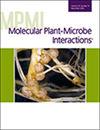Yi Yun Tan, Yin Yin Liew, Rachelle R Q Lee, Baptiste Castel, Nga Man Chan, Wei-Lin Wan, Yizhong Zhang, Donghui Hu, Persis Chan, Sang-Tae Kim, Eunyoung Chae
求助PDF
{"title":"Generation of Inheritable A-to-G Transitions Using Adenine Base Editing and NG-PAM Cas9 in <i>Arabidopsis thaliana</i>.","authors":"Yi Yun Tan, Yin Yin Liew, Rachelle R Q Lee, Baptiste Castel, Nga Man Chan, Wei-Lin Wan, Yizhong Zhang, Donghui Hu, Persis Chan, Sang-Tae Kim, Eunyoung Chae","doi":"10.1094/MPMI-10-24-0127-TA","DOIUrl":null,"url":null,"abstract":"<p><p>Towards precise genome editing, base editors have been developed by fusing catalytically compromised Cas9 with deaminase components, mediating C-to-T (cytosine base editors) or A-to-G (adenine base editors) transition. We developed a set of vectors consisting of a 5'-NG-3' PAM-recognizing variant of SpCas9 with adenosine deaminases TadA7.10 or TadA8e. Using a phenotype-based screen in <i>Arabidopsis thaliana</i> targeting multiple <i>PDS3</i> intron splice sites, we achieved up to 81% somatic A-to-G editing in primary transformants at a splice acceptor site with NGG PAM, while 35% was achieved for the same target adenine with NGA PAM. Among tested vectors, pECNUS4 (Addgene #184887), carrying TadA8e, showed the highest adenine base editor (ABE) efficiency. With pECNUS4, we recreated a naturally occurring allele of <i>DANGEROUS MIX3</i> (<i>DM3</i>) in two generations, transgene-free, for NGC PAM. We also simultaneously base-edited four redundant <i>DM1/SSI4</i> homologs, encoding nucleotide-binding leucine-rich repeat (NLR) proteins, using a single gRNA with NGA PAM targeting the conserved yet functionally crucial P-loop motif of NLR proteins. We found fixation of A-to-G in three NLR genes for all three possible adenine sites within base-editing window 3-9, as the edited genes segregate in T<sub>2</sub>. Multigene targeting succeeded in rescuing the previously reported autoimmune phenotype in two generations. Mediating desired ABE on seven NLR genes simultaneously was successful as well; above 77% editing was achieved in six of the seven possible targets in a T<sub>1</sub> plant, with the remaining having a moderately high (32%) editing. ABE application to specifically inactivate functional motifs is anticipated to expedite the discovery of novel roles for proteins. [Formula: see text] Copyright © 2025 The Author(s). This is an open access article distributed under the CC BY 4.0 International license.</p>","PeriodicalId":19009,"journal":{"name":"Molecular Plant-microbe Interactions","volume":" ","pages":"30-42"},"PeriodicalIF":3.4000,"publicationDate":"2025-02-01","publicationTypes":"Journal Article","fieldsOfStudy":null,"isOpenAccess":false,"openAccessPdf":"","citationCount":"0","resultStr":null,"platform":"Semanticscholar","paperid":null,"PeriodicalName":"Molecular Plant-microbe Interactions","FirstCategoryId":"99","ListUrlMain":"https://doi.org/10.1094/MPMI-10-24-0127-TA","RegionNum":3,"RegionCategory":"生物学","ArticlePicture":[],"TitleCN":null,"AbstractTextCN":null,"PMCID":null,"EPubDate":"2025/2/25 0:00:00","PubModel":"Epub","JCR":"Q2","JCRName":"BIOCHEMISTRY & MOLECULAR BIOLOGY","Score":null,"Total":0}
引用次数: 0
引用
批量引用
Abstract
Towards precise genome editing, base editors have been developed by fusing catalytically compromised Cas9 with deaminase components, mediating C-to-T (cytosine base editors) or A-to-G (adenine base editors) transition. We developed a set of vectors consisting of a 5'-NG-3' PAM-recognizing variant of SpCas9 with adenosine deaminases TadA7.10 or TadA8e. Using a phenotype-based screen in Arabidopsis thaliana targeting multiple PDS3 intron splice sites, we achieved up to 81% somatic A-to-G editing in primary transformants at a splice acceptor site with NGG PAM, while 35% was achieved for the same target adenine with NGA PAM. Among tested vectors, pECNUS4 (Addgene #184887), carrying TadA8e, showed the highest adenine base editor (ABE) efficiency. With pECNUS4, we recreated a naturally occurring allele of DANGEROUS MIX3 (DM3 ) in two generations, transgene-free, for NGC PAM. We also simultaneously base-edited four redundant DM1/SSI4 homologs, encoding nucleotide-binding leucine-rich repeat (NLR) proteins, using a single gRNA with NGA PAM targeting the conserved yet functionally crucial P-loop motif of NLR proteins. We found fixation of A-to-G in three NLR genes for all three possible adenine sites within base-editing window 3-9, as the edited genes segregate in T2 . Multigene targeting succeeded in rescuing the previously reported autoimmune phenotype in two generations. Mediating desired ABE on seven NLR genes simultaneously was successful as well; above 77% editing was achieved in six of the seven possible targets in a T1 plant, with the remaining having a moderately high (32%) editing. ABE application to specifically inactivate functional motifs is anticipated to expedite the discovery of novel roles for proteins. [Formula: see text] Copyright © 2025 The Author(s). This is an open access article distributed under the CC BY 4.0 International license.
利用拟南芥中的腺嘌呤碱基编辑和 NG-PAM Cas9 生成可遗传的 A-G 转换。
为了实现精确的基因组编辑,人们开发了碱基编辑器,将催化受损的 Cas9 与脱氨酶成分融合,介导 C-to-T(胞嘧啶碱基编辑器)或 A-to-G(腺嘌呤碱基编辑器)转换。我们开发了一套载体,由 SpCas9 的 5'-NG-3' PAM 识别变体与腺苷脱氨酶 TadA7.10 或 TadA8e 组成。我们在拟南芥中进行了基于表型的筛选,以多个 PDS3 内含子剪接位点为目标,在 NGG PAM 的剪接受体位点,我们在初级转化体中实现了高达 81% 的体细胞 A-G 编辑,而在 NGA PAM 的相同目标腺嘌呤上实现了 35% 的体细胞 A-G 编辑。在测试的载体中,携带 TadA8e 的 pECNUS4(Addgene #184887)的 ABE 效率最高。通过 pECNUS4,我们用两代无转基因的 NGC PAM 重现了 DANGEROUS MIX3 (DM3) 的天然等位基因。我们还同时对编码核苷酸结合富亮氨酸重复(NLR)蛋白的四个冗余 DM1/SSI4 同源物进行了碱基编辑,使用的是 NGA PAM 的单个 gRNA,其靶标是 NLR 蛋白保守但功能上至关重要的 P 环基序。我们发现,在碱基编辑窗口 3-9 内,三个 NLR 基因中所有三个可能的腺嘌呤位点的 A-to-G 都固定不变,因为编辑过的基因会在 T2 中分离。多基因靶向成功地在两代内挽救了之前报道的自身免疫表型。同时对七个 NLR 基因进行所需的 ABE 也取得了成功;在 T1 植株中,七个可能的目标基因中有六个的编辑率超过了 77%,其余基因的编辑率中等偏高(32%)。应用 ABE 特异性地使功能基因失活,有望加快发现蛋白质的新作用。
本文章由计算机程序翻译,如有差异,请以英文原文为准。

 求助内容:
求助内容: 应助结果提醒方式:
应助结果提醒方式:


